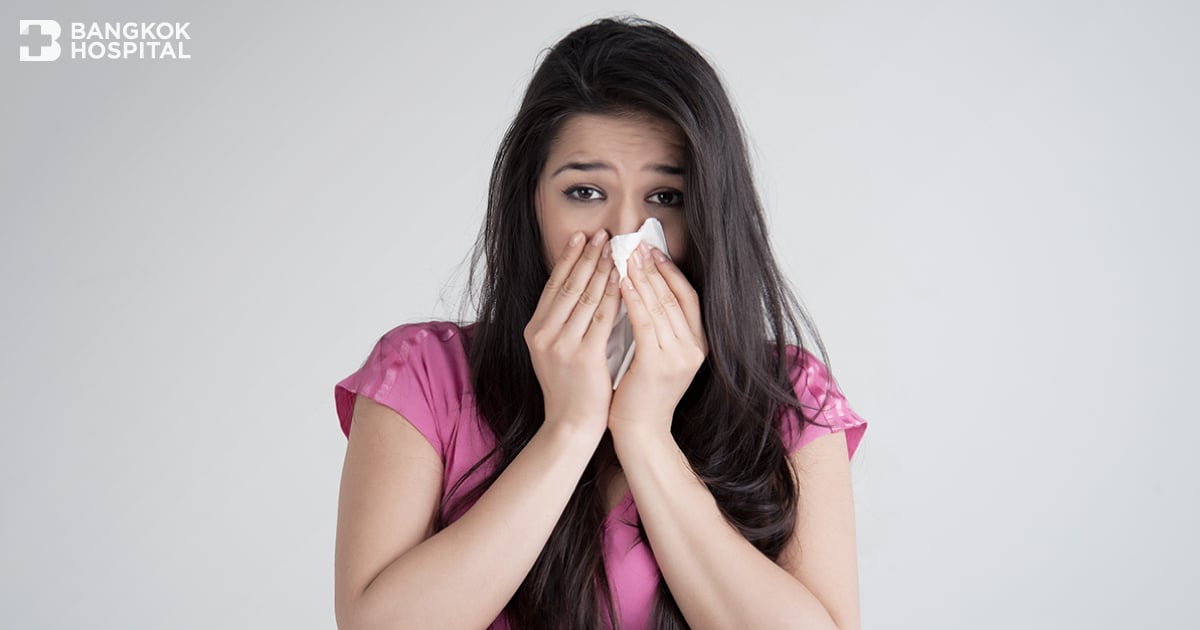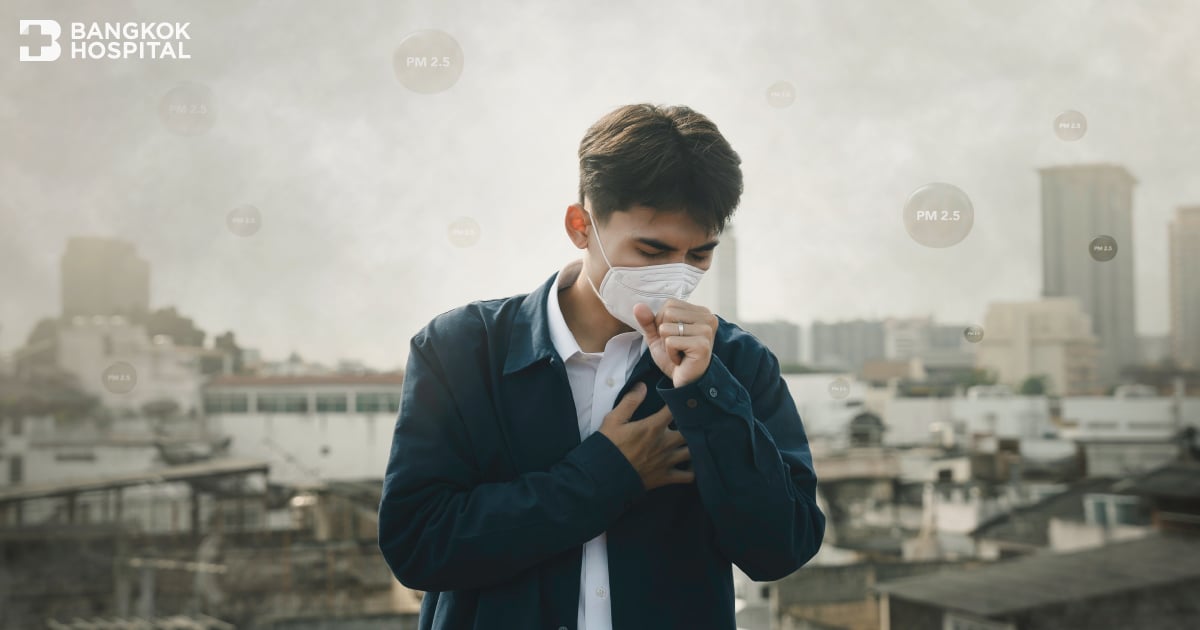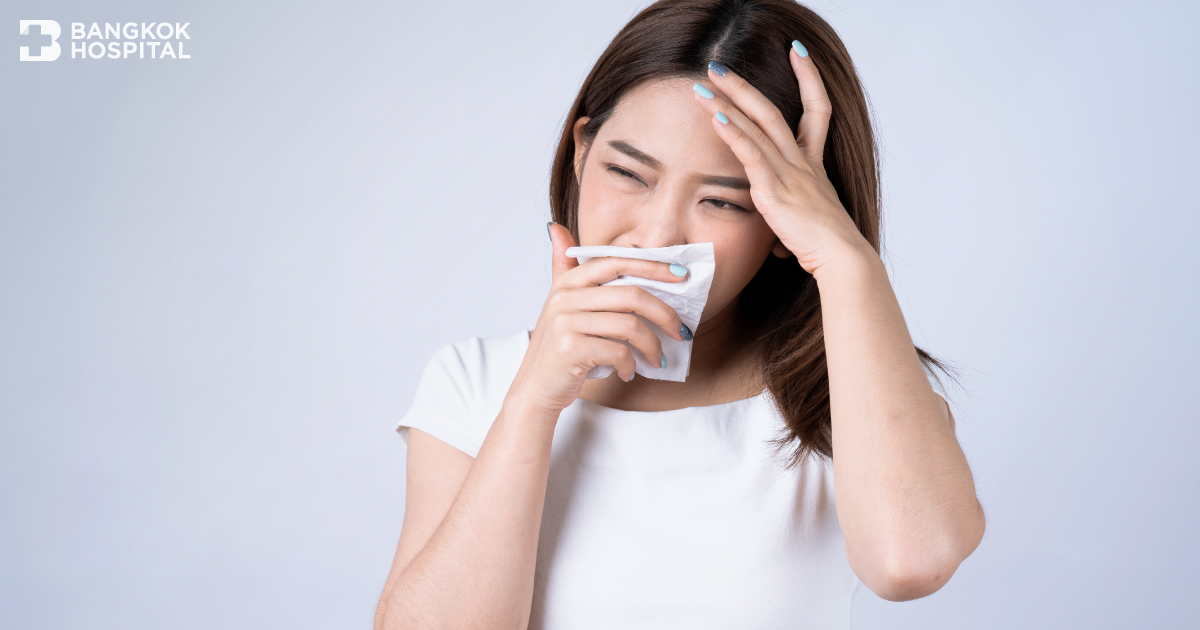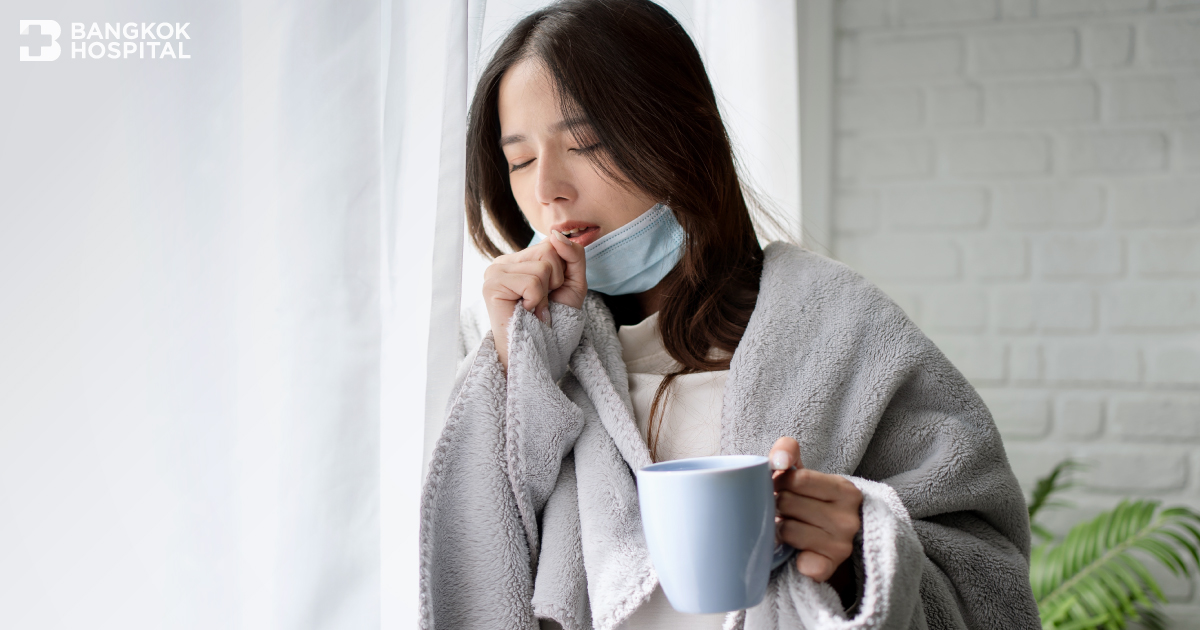Colds are diseases that can be found throughout the year and in people of all genders and ages. When having a cold, each person may have different symptoms and might only have some of the symptoms, but the cause of a cold comes from the same source, which is an infection in the upper respiratory tract
Colds
When referring to a cold, it implies the patient has symptoms of upper respiratory tract infection, meaning the parts above the vocal cords in the trachea up to the throat and nose, which can be divided into symptoms according to the organs involved, such as- In the nose: there will be a runny nose, stuffy nose, nose irritation, sneezing
- In the throat: there will be a sore throat, itchy throat, scratchy throat, cough, red throat, swollen tonsils, red and pus-filled
- In the upper trachea: there will be phlegm, hoarseness, voice change
It may also have other symptoms beyond those of the respiratory tract, such as
- Fever
- Body ache
- Chills
- Nausea
- Headache
- Dizziness
- Body pain
- Loss of appetite
- Diarrhea
- Rash
Treatment of Colds
When having a cold, what you need to do is to observe whether it is a viral cold or a bacterial cold because there are different treatments for each. Most colds are viral, characterized by a slightly sore throat, a little runny nose, a mild cough and cold, slightly exhausted feeling, and can recover on their own after about 2 – 3 days by just getting enough rest. Sometimes you may not even realize you are having a cold; a single dose of paracetamol might suffice for recovery without needing to see a doctor. Colds are diseases caused by airborne viruses; there are no direct treatments (as most viruses don’t have a cure), just symptom management, and waiting for it to heal on its own, which could be up to 70 – 80% of the cases.
Distinguishing Viral from Bacterial Colds
If the cold is severe enough to be a problem requiring medical attention, try to notice whether it’s caused by a virus or bacteria, as follows:
1) Observe Your Symptoms
Check if you have a viral or bacterial cold by observing the color of your mucus and phlegm. If it’s a bacterial cold, the mucus or phlegm will turn yellow or green because when white blood cells, which are our body’s soldiers against diseases, fight the bacteria, it reacts with enzymes in the white cells producing yellow or green color. Thus, when phlegm turns from clear or white to yellow or green, sometimes brown or bloody, it’s mostly a bacterial cold requiring antibiotics (or antibacterial drugs).
2) Open Your Mouth and Look in the Throat
Opening your mouth to examine your throat as when visiting a doctor can be done using a flashlight to inspect the throat in a mirror, if possible, using white light, like turning on a flashlight from a phone. The important thing is when opening your mouth wide, you should inhale through the mouth so that the tongue lowers, the uvula rises, opening up to show the back of the throat without having to stretch or flick the tongue because it would block the view. Some people cannot be seen this way if they have a particularly large tongue.
Once opened and the throat is visible, look for signs of bacterial infection to consider antibiotics. Check if the throat is red, if the tonsils on both sides are swollen, red with pus, or if the uvula is red and inflamed. If the throat appears quite normal, slightly red, it’s hard to tell whether it’s bacterial or viral. But if the throat is very red, has pus, the uvula and tonsils are swollen red with pus, it’s likely bacterial and might not recover on its own or would take a long time.
3) Observing Influenza Symptoms
Influenza virus is one of the exceptions of viral colds having a direct treatment, which is Oseltamivir or known as Tamiflu.
-
Viral infection is notable for symptoms in several systems beyond the respiratory tract symptoms, such as nausea, vomiting, loss of appetite, diarrhea (gastrointestinal system), body aches, muscle soreness, joint pain (muscles, bones, and joints system), red eyes, rash (skin system), etc., collectively called Viral Syndrome, which is the term for viral infection symptoms. There are different types of viruses causing diseases from the common cold, influenza virus, dengue virus causing dengue fever, hepatitis virus, to HIV causing AIDS.
-
At the onset of the viral infection, symptoms appear similar, making it hard to distinguish between different diseases until more specific symptoms of the disease emerge.
– If presenting with viral infection symptoms like nausea, loss of appetite, body pain combined with severe cold symptoms, suspect influenza.
– If viral symptoms come with high fever following a mosquito bite, suspect dengue fever.
– With viral symptoms and jaundice, think of hepatitis virus.
– If viral symptoms subside on their own, but later lead to low immunity, frequent infections, consider HIV. Initial symptoms might resemble a cold with rash, dismissed until more severe AIDS symptoms develop. Being cautious with sexual health practices can prevent worry as it doesn’t easily transmit. -
Monitor for other symptoms; knowing it’s a cold, the next step is treatment.
4) Antibiotics
For cold treatments, there are 2 groups: antibiotics and symptomatic treatment medications. There are two types: anti-inflammatory antibiotics (Antibiotics or antimicrobials) and anti-inflammatory pain relievers (NSAIDs).
Antibiotics for treating colds are of two kinds: antiviral drugs and antibiotics.
- Antiviral drugs, there is only one kind: influenza antivirals (Oseltamivir or Tamiflu).
- For bacterial infections, several groups of antibiotics are commonly used, primarily the penicillin group, initially Amoxicillin, called “amoxicillin”, produced by various companies both domestically and internationally, named differently depending on the company, with different color capsules.
- Another group of drugs for treating viral colds, especially for those allergic to penicillin, is Roxithromycin, brand name Rulid, which is also produced by several domestic companies under different brand names.
Therefore, patients should read the medication’s name to know what they are consuming before consulting a doctor or buying a new drug in a pharmacy. Additionally, each medication has a different intake method, such as taking one pill at a time or two, how many times a day, some after meals, some before meals, some for 3 days, others for 5 days or 7 days. Therefore, if unsure, consult a doctor and do not self-medicate.
5) Principles of Taking Antibiotics
The principle of taking antibiotics is, if our body’s soldiers, the white blood cells, are not strong enough to fight the infection, we need antibiotics as extra weaponry in the battle. Thus, ensuring adequate dosage, complete courses, and sufficient duration to entirely eliminate the infection. Not taking sporadically or stopping once symptoms improve, as some bacteria might survive the initial attack and develop resistance, coming back stronger, leading to drug-resistant infections.
6) Influenza Damages Respiratory Tract Membranes
Influenza is caused by a virus that damages the respiratory tract’s membranes, akin to destroying a home’s fences. Thus, bacterial infections may occur subsequently. Initially, it may appear as a viral infection with cold symptoms, but after taking antiviral medication, the fever might subside, and appetite returns. Then, after 2 – 3 days, fever may rise again, and phlegm may turn yellow or green, indicating a bacterial infection, potentially requiring antibiotics as well.
7) Symptomatic Treatment
Medications used for symptomatic treatment, such as cough medicines, mucus thinners, antihistamines to reduce mucus, decongestants, pain and fever reducers, lozenges, throat sprays, gargles, are to alleviate various cold symptoms, making you feel more comfortable. You may take these medications as needed and stop when symptoms subside, waiting for the antibiotics to act fully. Considering any history of allergies and possible side effects of some medications that may cause drowsiness, heart palpitations, constipation, etc., patients should remember which medications they prefer or dislike to inform the doctor next time.
After taking medications for colds, observe if symptoms improve. If feeling better and more comfortable, the medication is effective. But if no improvement or worsening occurs within 2 – 3 days, revisit the doctor. If improving but returning to previous symptoms upon stopping antibiotics, like sore throat, fever, coughing, and phlegm, consider revisiting the doctor to check for drug-resistant infections, needing the same or stronger antibiotics. Sometimes it might seem better, but not fully recovered, like continuous mild cough, mucus, or occasional fevers, some may neglect it for 1-2 months, forgetting it started with a cold. It might require continuing medication until completely healed and regaining full health.
Complications from Colds
If having a cold, there may be other complications depending on existing chronic conditions or specific body characteristics that increase the risk of secondary infections, such as
-
Sinusitis: When having a cold, nasal congestion and swollen nasal membranes can extend to the sinuses near the nasal and forehead cavities, causing pus or mucus to accumulate in the sinus cavities, known as sinusitis, characterized by sinus pain, nasal voice, smelly breath. The treatment involves medications similar to those for colds, but possibly stronger antibiotics under a doctor’s care, including self-nasal irrigation to help reduce pathogen levels and ease breathing.
-
Ear Infections: Because the ear and throat are connected by the Eustachian tube, when having a cold, the various inflamed membranes can cause this tube to swell and block, preventing the balance of air pressure in the middle ear chamber, causing ear pain or sometimes leading to a bacterial infection in the middle ear, resulting in middle ear infections or otitis media with effusion. Treatment might involve antibiotics capable of combating pathogens causing ear infections or including ear drops.
-
Bronchitis, Pneumonia: When pathogens descend the trachea to the lower parts entering the lungs, it can cause bronchitis or pneumonia, characterized by increased coughing, fever, or shortness of breath. In severe cases, hospitalization to receive intravenous antibiotics might be necessary.
-
Asthma: For individuals with pre-existing asthma, characterized by hypersensitive and constricting airways difficulting breathing or wheezing, it’s an urgent condition requiring immediate intervention to relieve constricted airways with bronchodilators. Thus, people with asthma should treat colds promptly to prevent exacerbation.
-
Febrile Seizures: Common in children under 6 years of age, it’s vital to reduce fever promptly through sponging or administering fever-reducing medications. Do not let the child remain with a high fever for long to prevent seizure episodes and treat the cold to recovery.
Preventing Colds
-
Colds are transmitted through air or secretions from infected individuals, like sneezing. Others, especially those with weaker immune defenses, possibly due to lack of sleep, insufficient rest, lack of exercise, might catch a cold easily. Thus, when having a cold, wear a mask to cover the mouth and nose to prevent spreading it to others or, if you wish to avoid catching a cold from others, wear a mask in crowded places, public transportation, meeting rooms, especially hospitals which are hubs for pathogens. Wearing a mask helps prevent infection, along with frequent hand washing to reduce the chances of catching a cold.
-
If experiencing bacterial colds with inflamed tonsils more than 6 times a year or every 2 months, consider consulting an otolaryngologist for a possible tonsillectomy, which could reduce the frequency of colds. If suffering from frequent colds nearly every month or a drug-resistant cold, reevaluate personal health care. Allowing the body to become weakened to frequent illnesses, it’s time to rebalance life, ensuring adequate rest, exercising, reducing stress, or increasing intake of fruits, vegetables, and immune-boosting supplements.







